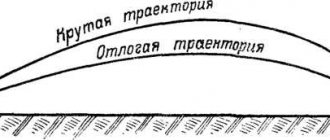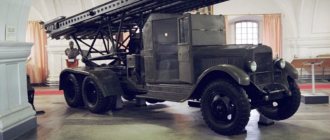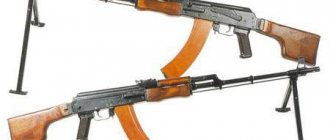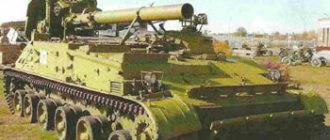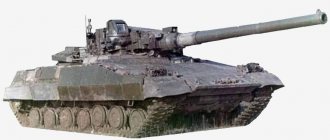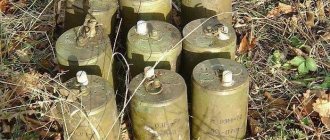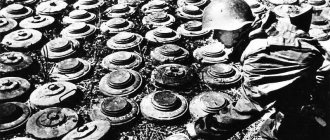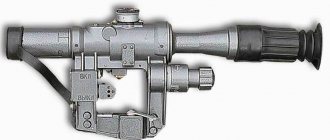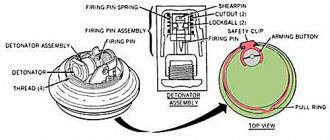MOSCOW, November 13 – RIA Novosti, Andrey Kots. These military specialists are trained to operate in the most lethal environments possible. Their “office” is the epicenter of a recently thundered nuclear explosion, a city infected with a deadly disease, or trenches “flooded to the brim” with chemical warfare gases. On Monday, November 13, soldiers, officers and warrant officers of the Radiation, Chemical and Biological Defense Forces (RCBZ) celebrate their professional holiday. According to the Ministry of Defense, by the end of the year, individual RCBZ brigades should receive more than 350 units of special equipment, including the TOS-1A Solntsepek heavy flamethrower systems. RCBZ specialists are the only ones in the Armed Forces who are allowed to “play with fire” in the literal sense. About the most withering weapon of the Russian army - in the material of RIA Novosti.
the main objective
The experience of the Great Patriotic War showed the effectiveness of backpack flamethrowers and at the same time their shortcomings. On the one hand, the stream of sticky flame had a colossal demoralizing effect on enemy soldiers, burned trenches, dugouts and firing points to the ground, and blinded armored vehicles. On the other hand, the infantry ROKS, ROKS-2 and ROKS-3 (Klyuev-Sergeev backpack flamethrower) weighed as much as 23 kilograms, threw out a stream of fire only 40 meters and very quickly consumed their ammunition. It was only enough for six to eight short salvos or one or two long ones. In addition, the massive cylinders behind his back immediately revealed to the enemy his specialization as a Red Army soldier. Needless to say that as soon as a Soviet flamethrower appeared in the Wehrmacht soldiers’ line of sight, they started shooting at him with all guns?
The Soviet designer Evgeniy Kozlovsky tried to correct the shortcomings of this weapon after the war. His LPO-50 light infantry flamethrower was adopted by the Soviet Army in the mid-1950s. Despite the fact that it weighed the same as the ROKS, the cylinders were made more compact, and the firing range was increased to 70 meters. The supply of fire mixture was enough for three aimed salvoes lasting two to three seconds each. This was enough for an experienced shooter to create a real hell in front of him. Thickened gasoline (aka napalm) burned at a temperature of more than a thousand degrees, stuck to all surfaces and flowed into all cracks. The heavy version - TPO-50 - hit a canopy of 180 meters, weighed 173 kilograms, and its operation required a combat crew of two people.
| Light infantry flamethrower LPO-50. |
| Source: RIA Novosti |
But the era of jet backpack flamethrowers (as well as their heavy high-explosive counterparts and flamethrower tanks) was coming to an end. Assault rifles have become the standard small arms of the developed countries of the world, which, thanks to their rate of fire and target firing range of more than 400 meters, have significantly expanded the boundaries of fire contact. The last major armed conflict where jet flamethrowers were used en masse was the Vietnam War. The Americans completely abandoned their M9 backpacks in 1978, the Soviet Union a little earlier.
What is special about RPO-2?
According to the head of the RKhBZ troops, the RPO-2 flamethrower will have increased combat capabilities. It is planned to be placed on UAVs for sighting and shooting systems. When using a flamethrower system from a drone, the accuracy of its use can significantly increase. The combat mission of increasing the “coverage” of the attacked territory can also be solved. General Igor Kirillov does not provide any specific details about the RPO-2, nor does he say when this weapon might arrive in the RKhBZ troops.
Pocket artillery
Today, the LPO-50 continues to be in service with only a few countries - Vietnam, North Korea, and China (a licensed copy of the Type 74). In the USSR, all flamethrowers of this type were mothballed by 1975, when a fundamentally new weapon appeared in the Soviet army. The infantry rocket flamethrower (RPO) “Lynx” differed from all its predecessors in that the fire mixture in a special capsule was fired “grenade launcher style” - using a jet engine. The target range of this RPO is about 190 meters, but a well-aimed shooter could hit the target at 400 meters. Structurally, the Lynx consists of a launcher that is largely unified with the RPG-16 hand-held anti-tank grenade launcher. Along the flight path, the shot capsule is stabilized by the tail.
| A radiation, chemical and biological defense company firing from a Lynx hand-held anti-tank flamethrower in the Ryazan region. |
| Source: RIA Novosti / Alexey Kudenko |
RPO "Lynx" was baptized by fire in Afghanistan, where it was actively used by flamethrower battalions of the Russian Chemical Defense Plant. However, expectations from this weapon were not fully met. The weight and size characteristics were not the most convenient - the one and a half meter length of the starting device and the weight with additional charges of more than 20 kilograms. In addition, the firing range was not enough in mountainous areas, and the fire mixture did not always effectively set fire to the stone and adobe fortifications of the dushmans.
However, already at the end of the Afghan war, the Lynx was replaced by a much more powerful weapon, which remains the hallmark of the RCBZ troops today. The legendary “Shaitan-pipe”—the Bumblebee infantry flamethrower—is called pocket artillery by the military itself. In terms of its high-explosive impact, it is not inferior to 122-152 mm artillery shells. The excellent range and good aiming ability of the product allowed Soviet soldiers to literally burn out militants from buildings and shelters, and reach mortar and machine gun crews in gorges and folds of the terrain.
| A serviceman of the Russian Armed Forces with the RPO-A “Shmel”. |
| Source: twower.livejournal.com |
The peak of combat use of "Bumblebees" occurred in Chechnya, Dagestan and other areas of military operations in the North Caucasus. The latest modifications of the flamethrower have a firing range of up to 1700 meters. Of course, for such a weapon this indicator is clearly excessive, but any target located within a kilometer radius of the flamethrower - be it a tank, an infantry detachment, a firing point or a building - falls into the destruction zone.
The Bumblebee's most powerful ammunition is a thermobaric rocket. Before detonating, it sprays a special flammable aerosol around the target, which a split second later is ignited by an ignition charge. Everything in the affected area burns out - even the air. One well-aimed hit destroys all living things in a volume of up to 80 cubic meters. Covered targets are disabled due to pressure drop even without breaking through the barrier, if they are not sealed. A tank or infantry fighting vehicle with an open hatch is a guaranteed “dead man.” But fully battened armored vehicles cannot feel safe. The shaped charge in the front of the Bumblebee capsule acts as a ram, penetrating the armor. A deadly aerosol instantly flows into the resulting gap.
Striking with fire. Russian flamethrower weapons
Modern domestic flamethrowers, which can be classified according to their operating principle as any means capable of delivering fire to a target, trace their origins back to the ancient bow, whose burning arrow pierced the wooden gates of castles and fortresses.
All flamethrowers currently in service with armies are divided into jet, capsule-jet and capsule. During the Great Patriotic War and in the post-war period, jet flamethrowers were widely used in the Soviet Armed Forces, which threw a fiery stream at the target, ignited by the force of the flame at the muzzle of the flamethrower. Such flamethrower weapons, in addition to their main task - defeating enemy personnel both during offensive and defensive combat operations, also carried the function of a powerful psychological impact, which, in combination with effective fire from small arms, tanks and artillery, led to the effective completion of assigned tasks at the tactical level. However, such weapons had many disadvantages, and first of all, they were extremely uneconomical, since part of the fire mixture burned uselessly during the flight.
After the end of World War II, flamethrower weapons were again in demand, but at a qualitatively new level.
The Soviet Armed Forces were in dire need of effective infantry close combat weapons, among which flamethrowers played a significant role. Considering the importance of incendiary weapons, gunsmith designers began work on new types of flamethrower weapons in the late 1940s, including light, heavy, and disposable flamethrowers. Heavy infantry flamethrower TPO-50
Already in the mid-1950s, two new types of flamethrower weapons were adopted by the Soviet army: the heavy infantry flamethrower TPO-50 and the light infantry flamethrower LPO-50.
The heavy infantry flamethrower TPO-50, and subsequently its modernized version TPO-50M, was intended to destroy enemy personnel located openly or in shelters, as well as to repel enemy attacks and counter-attacks. The targets were hit with a burning fire mixture.
The TPO-50 and TPO-50M flamethrowers were gunpowder weapons, piston-powered, horizontal, with a carriage, reusable, with mechanical and electrical methods of actuation. Flame throwing from TPO-50 and TPO-50M was carried out from a carriage, and in some cases it could be carried out from an inclined trench when installing replaceable flamethrower barrels in the ground. The TPO-50 flamethrower was crewed by two flamethrowers: a gunner and an assistant flamethrower gunner.
The action of the TPO-50 flamethrower was based on the ejection of the fire mixture by the pressure of the powder gases formed during the combustion of the powder charge. The jet of fire mixture was ignited as it left the nozzle with the flame of an incendiary star. A special feature of the TPO-50 heavy flamethrower was that the gas pressure on the liquid was transmitted through a special piston-obturator, which separated the liquid and gas areas in the flamethrower barrel.
The heavy infantry flamethrower TPO-50 (TPO-50M) weighing 173 kg consisted of three identical interchangeable barrels and a carriage, which made it possible to fire three shots of 21 liters of fire mixture each at a distance of up to 180 m. For flamethrowing, the flamethrower was provided with special ammunition.
The replaceable barrel of the TPO-50 consisted of a body and head connected by a union nut, a powder chamber, a nozzle with a locking device, a safety valve, a shutter piston, a mechanical fuse or electrical contact, a front sight and a sight. The body of the replacement barrel was intended to contain the fire mixture and create working pressure and was made of alloy steel 3.5 mm thick; the sighting frame block and the stop of the triple clamp were welded to it. On the stamped spherical bottom of the body there was a boss for attaching the barrel to the carriage. A handle was attached to the tide holes, by which the barrel was carried by a flamethrower.
The most important part of the replacement barrel was the head, on which all the working components of the flamethrower were mounted. It had a ring for connection to the body. A siphon bushing, a powder chamber glass and a safety valve bushing were welded into the spherical part of the head. The inner part of the siphon sleeve passed into a siphon pipe, through which the fire mixture was thrown out of the barrel. To allow residual powder gases to escape from the replaceable barrel at the end of the flamethrower shot, there were holes in the piston-obturator sleeve and in the lower part of the siphon pipe. The piston-obturator moved along the siphon pipe and served to uniformly distribute the pressure of the powder gases on the surface of the fire mixture when it was ejected from the barrel of the flamethrower during a shot. The powder chamber was mounted on the glass of the powder chamber and was intended to place on it an ignition charge (incendiary star), a powder charge, a gas nozzle grate and other parts that ensure the production of a flamethrower shot. On the cover of the powder chamber there were holes for the torch tube of the capsule contact (with the electric method of actuating the flamethrower) and for a mechanical fuse. The torch tube served to release the flame of the incendiary star, which ignited the jet of the flamethrower.
When firing from a TPO-5 heavy infantry flamethrower using a mechanical fuse, the ignition cartridge of the ROKS-3 backpack flamethrower was inserted into the sleeve of the mechanical fuse and the mechanical fuse was screwed in; in the case of using an electrical contact, a brass contact was used to activate the flamethrower, and in place of the bushing of the mechanical fuse, a bushing with an electrical contact was screwed in to ignite the PP-9 squib.
Installation of a heavy infantry flamethrower TPO-50 in a trench and replaceable barrels in inclined trenches.
The nozzle served to form a jet of fire mixture and direct it to the target. The nozzle diameter was 32 mm. The nozzle included a body and a locking device, which was necessary to create a working pressure of up to 60 kg/sq.cm in the flamethrower barrel, at which the shot occurred. The nozzle body had a conical part with a central cone angle of 16 degrees and a cylindrical part with a length of 96 mm, equal to three diameters of the nozzle section. The nozzle was closed with an aluminum membrane rigidly connected to the punch. The punch ensured a clean cut of the membrane under pressure from the fire mixture during the shot. A diaphragm-type safety valve with a diameter of 25 mm was mounted on the head, which served to prevent the creation in the flamethrower barrel of a pressure dangerous to the barrel structure - over 120 kg/sq.cm.
The sight was used for targeted flamethrowing from the TPO-50 heavy infantry flamethrower at a direct shot range. The sight consisted of a sighting frame, clamps with slots for aiming at the target and a front sight. Numbers were stamped on the clamps of the aiming frame, indicating the range of flamethrowing with a direct shot at a target height of 1.5 m. Number 1 corresponded to a range of 100 m, number 1.2 - a range of 120 m, number 1.4 - a range of 140 m. When firing from a flamethrower at a distance of more than 140 m, the sight was used to horizontally aim the flamethrower barrel in the direction of the target to be hit.
One of the main components of the TPO-50 flamethrower was the carriage, which was intended: for transporting the TPO-50 heavy infantry flamethrower on wheels and on skis; to perceive the recoil force when firing; to change the elevation angles of the replacement barrel.
A special device was intended for transporting three replaceable barrels on a carriage and consisted of a triple clamp and a removable bracket. Using a removable bracket, the side replaceable barrels of the flamethrower were attached to the carriage frame. A triple clamp was attached to the middle barrel of the flamethrower, and its side clamps fixed the side replaceable barrels of the flamethrower on the middle barrel of the flamethrower.
The carriage frame served to absorb the recoil force of a flamethrower shot and hold the flamethrower in place at the moment of the shot. The frame rested with the front coulter on the ground, and with the rotating coulter, it rested on the ground or a solid support (stump, tree, wall).
The TPO-50 flamethrower was transported by the handle on wheels, and in winter - on skis. The time to prepare the TPO-50 flamethrower for action from the traveling position was no more than 8-10 minutes, and for its improved model TPO-50M - 2 minutes.
For flamethrowing from the TPO-50 heavy infantry flamethrower, the following ammunition was used: fire mixture, powder charges weighing 403 g, incendiary stars and ROKS-3 ignition cartridges - with a mechanical method of actuating the flamethrower, or PP-9 squibs with an electrical method.
The modernized TPO-50M flamethrower differed from its prototype in its body, which was now mounted on a carriage, and in a device for equipping the flamethrower using two eyes. The presence of slots in the barrel lugs and a bevel in the axis of the barrel mounting on the carriage made it possible to quickly change barrels into position.
The TPO-50M flamethrower had a powder chamber with a gas nozzle combined with a grate.
A jet nozzle was installed on the glass of the powder chamber, in the gas area of the barrel, through which some of the powder gases were released upward during the shot. The resulting reaction force pressed the barrel to the ground, helping to eliminate the vertical movement of the flamethrower (bouncing) when fired. Flamethrowing from a light infantry flamethrower LPO-50
Flamethrowing from a heavy infantry flamethrower TPO-50 (TPO-50M) was carried out with viscous fire mixtures prepared on the basis of benzene head or gasoline and thickening powder OP-2. The ROKS-3 igniter cartridge (which was a TT pistol cartridge case, equipped with a pyrotechnic ignition composition) and PP-9 squibs (consisting of a tinned copper sleeve of a contact core, an electric igniter, a contact cup, and a charge of black gunpowder) were intended to ignite the incendiary star.
With the mechanical method of activating the flamethrower, the mechanical fuse ignited the ROKS-3 cartridge, and with the electrical method, the current from the BAS-80 battery or from the PM-1 or PM-2 blasting machine ignited the PP-9 squib. The flame of the incendiary star ignited the powder charge through the hole in the star cup. Powder gases formed during the combustion of a charge in the powder chamber entered the gas region of the flamethrower barrel through a gas nozzle and ensured the creation of a constant pressure of 60 kg/sq.cm in the gas region of the replaceable flamethrower barrel. Under the pressure of the powder gases, the fire mixture was squeezed out by a piston-obturator through a siphon pipe, cutting off the nozzle membrane and thrown onto the target. The speed of movement of the fire mixture in the barrel increased from 3 to 36 m/sec due to the difference in the diameters of the replacement barrel and the siphon pipe of the flamethrower (200 mm and 55 mm). The siphon pipe with a nozzle, having a sufficient length, contributed to a better establishment of normal fluid flow. The presence of a conical constriction and a cylindrical part of the nozzle with a diameter of 32 mm at the outlet section of the siphon pipe contributed to an increase in the exit speed of the flamethrower jet to 106 m/sec. When leaving the nozzle, the jet of fire mixture was ignited by the flame of an incendiary star emerging from the torch sleeve.
Advancement to the flamethrower position, depending on the situation, was carried out with three replaceable barrels mounted on a carriage, or with one replaceable barrel.
In the first case, the flamethrowers transported the flamethrower together, and in the second case, the flamethrower gunners moved out with one replacement barrel mounted on a carriage, and the gunner's assistant carried the remaining replacement barrels to the flamethrower position. When troops moved, flamethrowers were transported on vehicles. RPO "Lynx" infantry jet flamethrower
When flamethrowing at a stationary target, the aiming line had to pass through the target, the front sight and the slot of the sighting frame clamp, corresponding to the range of a direct flamethrower shot.
Flame-throwing at a moving target was carried out in the same way as against a stationary target at the actual flame-throwing range. When the target moved at an angle, the aiming point should be placed in the direction of the target's movement. Flame throwing was carried out by waiting for the target. To do this, in the zone of actual flamethrowing on the target's line of movement, a landmark was selected, along which the flamethrower gunner directed the flamethrower and determined the lead. Flame throwing was carried out at the moment when the target approached the aiming line at the calculated lead. In this case, the amount of lead was determined based on the flight speed of the flamethrower jet of 100 m/sec and the speed of the target.
Headwind or tailwind had no effect on aiming accuracy. With a strong headwind, the flamethrowing range decreased by 10-20 degrees compared to the range with a tailwind. The side wind, with a speed of up to 2 m/sec, had virtually no effect on the accuracy of a direct shot. With a side wind having a speed of 3-5 m/sec, the flamethrower jet was carried away, so when flamethrowing, the aiming point had to be moved to the windward side. With a wind speed of 3-4 m/sec and a flamethrowing range of 100-120 m, the aiming point was moved to the windward side by 1-1.5 m. With an oblique wind, the drift value was halved.
Flame-throwing at illuminated targets at night was carried out in the same way as during the day. At the moment the target was illuminated, the flamethrower gunner quickly aimed the flamethrower and fired the flame. In this case, the gunner should not have looked at the light source to avoid blinding.
Launching device for the RPO "Lynx" infantry jet flamethrower
Another example of a domestic incendiary weapon was the LPO-50 light infantry flamethrower, which turned out to be very effective in direct contact with the enemy in close combat.
LPO-50 was a backpack, powder, pistonless, multiple-action flamethrower with an electrical flame-throwing control method. The LPO-50 light infantry flamethrower was intended to destroy enemy personnel located in the open or in shelters - trenches, dugouts, etc. The targets of flamethrowing could also be wooden buildings and structures that need to be set on fire, based on the conditions of the combat situation. It could hit targets with a burning fire mixture at a distance of up to 70 m. At the same time, approximately 30 percent of the total volume of the fire mixture reached the maximum distance. However, the most effective distance for flamethrowing was 40-50 m. It was in this case that conditions were created for the complete destruction of targets.
The LPO-50 flamethrower consisted of a backpack with three cylinders for the fire mixture, a gun and a flexible hose made of petrol-resistant rubber. The hose connected the gun to the cylinders for the fire mixture. The capacity of each cylinder was 3.5 liters, which was enough to fire one shot. A feature of the light infantry flamethrower was the absence of a piston that pushes the fire mixture into the barrel of the gun (like the TPO-50). This role was played by powder gases.
The LPO-50 light infantry flamethrower gun was intended to fire a shot and direct the flamethrower stream at the target. The gun consisted of a barrel, chambers, stock, butt, handle with trigger and safety, switch, battery and electrical wires. A pipe for connecting a hose was mounted on the breech end of the barrel, and a nozzle was mounted on the muzzle end to reduce the diameter. There was a front sight on the nozzle. A clip was attached to the muzzle of the barrel, in which three chambers were mounted, where one incendiary cartridge was placed for each cylinder (PP-9 squibs and ignition charges of nitroglycerin powder with an igniter composition of black powder, placed in aluminum containers). One of them was triggered at the moment when the flamethrower pressed the trigger button.
Infantry jet flamethrower RPO-A “Shmel”
The barrel was connected to a butt with a folding metal back housing a battery. The LPO-50 used an electric trigger mechanism, which consisted of a trigger and a switch. The gun was protected from accidental shots using an automatic fuse located in the pistol grip of the fire control, as well as an electric switch, which, in the stowed position, disconnected the electrical circuit of the flamethrower. A switch was mounted in the flamethrower control box with four positions, designated by numbers: “0”, “1”, “2” and “3”. Using a switch, the sequence of firing the squibs and powder charges of the 1st, 2nd and 3rd cylinders was set. In the “0” position, all squibs and ignition charges were disconnected from the electrical circuit.
The flamethrower was powered by a battery consisting of two nickel-cadmium batteries placed in the butt of the gun. From these, current was supplied to ignition charges and squibs. The battery operated without recharging for about 5 years, allowing it to fire 500 shots within a year.
The stock of the gun protected electrical wires from damage and made it easier to use the weapon. The gun was equipped with a folding bipod, as well as a carrying belt.
Cylinders with fire mixture were connected to each other using a manifold. A hose was screwed to its nozzle, connecting the cylinders to the gun. The cylinders were attached to a pad made of metal mesh and tarpaulin, as well as carrying straps, allowing the LPO-50 to be carried on the flamethrower’s back.
At the top of each cylinder there was a powder chamber and two holes.
A glass was welded to one of them, intended for filling the tank with a fire mixture and placing a charge with a squib in it. The other contained an overpressure ball safety valve, designed to remove part of the powder gases from the cylinder if the pressure exceeded 40 kg/sq. see Firing from the RPO-A Shmel infantry flamethrower.
A pipe was mounted at the bottom of the cylinders connecting them to the manifold, which was common to all three cylinders.
A check valve was placed in the housing, which was held in the upper position by a spring and, with the help of a membrane, closed the hole for the release of the fire mixture from the cylinder into the manifold.
The LPO-50 flamethrower worked as follows. The flamethrower, having set the switch to one of the operating positions and taking aim, pressed the trigger button. In this case, the switch closed the electrical circuit, and current from the battery was supplied simultaneously to the ignition charge of the gun and the squib of one of the cylinders with a combustible mixture. The squib ignited a powder charge that burned for 1 second, as a result of the combustion of which an excess pressure of up to 30 kg/sq.m was created in the cylinder. cm. Thanks to this, the check valve, under the pressure of the fire mixture, broke through the membrane and moved down, opening the path of the fire mixture from the cylinder into the hose, and then into the barrel of the gun. The fire mixture ejected from the barrel of the gun was ignited by the fire of the ignition cartridge. After the fire mixture was released, the check valve, manifold, hose and gun barrel were purged with powder gases, which eliminated the leakage of the fire mixture from the muzzle of the gun after the shot. Then the pressure in the cylinder decreased, and the check valve, under the action of a spring, returned to the upper position, “locking” the cylinder.
The equipped LPO-50 flamethrower weighed 23 kg. It was carried on his back and used in battle by one flamethrower soldier. Flame throwing from the LPO-50 light infantry flamethrower could be carried out from various positions: lying down, standing, kneeling. The estimated time to bring the LPO-50 flamethrower from the traveling position to the combat position is no more than 20 seconds.
The LPO-50 light infantry flamethrower was a multiple-action weapon. The guaranteed number of trouble-free shots was at least 600, i.e. 200 shots from each cylinder.
With the help of light and heavy flamethrowers in battle it was possible to destroy enemy personnel located openly in trenches and other defensive structures; repel attacks and counterattacks of tanks and infantry; burn out garrisons of fortified buildings, permanent and other field structures.
Heavy flamethrowers TPO-50, TPO-50M could perform tasks in cooperation with infantry, artillery and in combination with engineering barriers.
In battles it was advisable to use them centrally. Sights of the RPO-A rocket infantry flamethrower
Light infantry flamethrowers were assigned to combined arms formations, units and subunits. In an offensive battle, flamethrowers advanced directly behind the infantry chain, operating in pairs at a distance of 40-50 m from each other. When approaching the target, fighters with light infantry flamethrowers, carefully camouflaged, advanced in front of the rifle units and, under the cover of their fire, destroyed the target with targeted flamethrowing.
In defense, soldiers with light infantry flamethrowers were positioned together with riflemen in the first trench with intervals between pairs of up to 50 m.
However, along with flamethrowers of the classical design, fundamentally new models of these weapons soon appeared. Thus, the specifics of the war in Vietnam led to the fact that already at the end of the 1960s, in addition to the latest small arms systems that were used in units of the US Army and Marine Corps, a special 66-mm reusable flamethrower, the XM 191, arrived. designed to fire incendiary grenades.
The American military command, based on combat experience gained during combat operations in South Vietnam, believed that incendiary weapons turned out to be extremely effective in defeating and demoralizing enemy personnel, strengthening engineering barriers, and illuminating the area at night in order to increase the effectiveness of artillery and machine gun fire. fire, to quickly destroy vegetation, if necessary, to unmask enemy troops, etc. Therefore, after quite a long period of use of the new weapon in the army, taking into account the expressed wishes and comments of the front-line units, this flamethrower was improved and already in 1974, its modernized version of the M202A1 flamethrower was adopted into service with the US ground forces, intended for hitting armored targets, vehicles, defensive structures, as well as fire weapons and manpower of the enemy, located openly or located in trenches or other shelters. It was fired from the shoulder with rocket-propelled grenades containing the TPA incendiary mixture, which, when the projectile hit an obstacle (target), splashed and ignited.
Following the “main enemy,” our gunsmith designers also paid close attention to new, very effective weapons.
After the first publications in the Western military press about the newest American flamethrower XM 191, the Soviet military, together with representatives of the Ministry of Defense Industry, were forced to develop a worthy answer. At the end of the 1960s, for the first time, our gunsmiths began to study the issue of creating a capsule-jet infantry flamethrower for arming motorized rifle and airborne troops. In 1972-1974, in order to strengthen infantry close combat weapons, specialists from the Tula Instrument Design Bureau created the Lynx reusable infantry flamethrowers (RPO), which soon took their rightful place in the infantry weapons system. Flamethrower shot from a rocket-propelled infantry flamethrower RPO
They were intended to defeat the enemy in open areas, destroy his hidden firing points, and disable automobile and lightly armored vehicles.
RPO "Lynx" consisted of a launcher created using individual parts and assemblies of the RPG-16 hand-held anti-tank grenade launcher and two types of missiles with a warhead filled with a fire mixture with an incendiary ("Lynx-Z") or smoke-forming ("Lynx D") composition . To better ensure stability on the parapet of a trench or on the ground when firing from this rather heavy weapon (weighing about 7.5 kg), a bipod mounted in front of the launcher served.
In the design of this weapon, the capsule-jet principle of flamethrowing was implemented for the first time: a flamethrower shot, assembled in a plastic container, was a “packaged” jet placed in a capsule on which a solid-fuel jet engine was mounted.
Bringing the flamethrower into firing position was carried out in just 60 seconds: the flamethrower shot was secured to the body of the flamethrower with three cap locks. After this, the flamethrower pulled the trigger. The jet engine was ignited by using the energy of an electrical pulse generated when the electrical mechanism was activated. When fired, the flame from the fuse was transmitted through the fire tube and ignited the jet engine, the charge of which was completely burned, and the body was separated from the capsule as the shot moved along the barrel. In flight, in order to increase the accuracy of fire, the shot was stabilized using 4 tail stabilizer feathers by rotating around its axis. Upon contact with an obstacle, the fuse was triggered, the capsule body was destroyed, the fire mixture was ignited, after which its burning pieces scattered over a distance of 30-40 m in the direction of fire. The target was hit due to the high combustion temperature. At the same time, flamethrowing from the RPO “Lynx” was accompanied by a strong sound and a significant backward ejection (at a distance of up to 45 m in the affected sector of 110 degrees) of a jet of high-pressure gases. Therefore, the presence of people and animals in this dangerous zone was prohibited.
Using the significant combat experience accumulated in Afghanistan, domestic specialists continued work on creating more effective models of flamethrowers. Back in 1976, the same Tula designers from KBP, under the leadership of General Designer A. Shipunov, began work on a more promising type of infantry jet flamethrowers based on the “Bumblebee” theme, and soon the RPO “Lynx” was replaced by a qualitatively new model of this weapon, the well-known called the RPO “Shmel” infantry jet flamethrower, but no longer reusable, but disposable.
The “Bumblebee” type flamethrower is a completely new version of the infantry jet flamethrower, in which, for the first time in domestic weapons, the capsule principle of flamethrowing is implemented, when a capsule with a fire mixture is delivered to the target in a “cold” state. The RPO-A flamethrower uses combined ammunition. Its cumulative warhead, being the first to pierce an obstacle, contributes to the deep penetration of the main warhead, filled with a fuel-air fire mixture, into the object. Upon impact, an ignition-explosive charge is initiated, as a result of which the fire mixture (aerosol cloud of liquid explosive) ignites and its burning pieces scatter and hit the target. The RPO-A Shmel flamethrower is characterized by high shooting accuracy. Since in flight the ammunition is stabilized by the tail due to rotation about the longitudinal axis, the deflection of hits at ranges of up to 200 m, as a rule, does not exceed 0.7-1.0 m.
This weapon is fired from the shoulder. The main feature of the new weapon is the absence of a starting device (gun) for flame-throwing the mixture. Instead, a disposable launch container is used, which is thrown away after the shot. The flamethrower consists of three main parts: a launch container, ammunition (capsule) with a warhead and a propulsion engine. The capsule's flight speed is 125 m/s. Targeting can be done using either simple sighting devices, consisting of a front sight and a movable rear sight that folds down on the aiming frame, or an OPO-1 optical sight. The firing mechanism of the RPO "Shmel" is housed in a separate housing, mounted on the outer part of the starting device and consists of a folding handle with a lock, the actual trigger mechanism housing with a trigger guard and safety lock, a firing mechanism in a casing and a capsule sleeve. For a more stable hold of the flamethrower when firing, an additional folding handle is attached to the RPO body. Handling this weapon also requires strict adherence to safety regulations, since when firing from the Shmel, the shot is accompanied by the release of a jet of high-pressure gases back (at a distance of up to 20 m).
“Bumblebees” were first used by Soviet troops in Afghanistan in 1983-1984 to “smoke out” dushmans from caves and underground shelters.
| Tactical and technical characteristics of jet flamethrowers | ||||
| RPO "Lynx" | RPO-A "Shmel" | RPO-Z "Shmel" | RPO-D "Shmel" | |
| Length in firing position, mm | 1440 | 920 | 920 | 920 |
| Total weight, kg | 7,5 | 11 | 12 | 12 |
| Warhead with fire mixture, l | 4 | 2,1 | 2,3 | 2,3 |
| Sighting range, m | 190 | 600 | 600 | 600 |
| Effective firing range, m | 350 | 350 | 350 | |
| Maximum firing range, m | 400 | 1000 | 1000 | 1000 |
| Time to transfer from traveling to combat position, sec | 60 | 30 | 30 | 30 |
The Soviet flamethrowers “Lynx” and “Bumblebee” gained great popularity among the troops, proving themselves to be formidable weapons in the mountains of Afghanistan, Tajikistan and Chechnya. In many military conflicts and local wars of recent years, in which the Soviet and then the Russian army participated, it was possible to sufficiently develop successful tactics for using rocket-propelled infantry flamethrowers. Based on the significant combat experience gained with the use of rocket-propelled infantry flamethrowers, it is believed that for their successful use it is necessary to carry out such activities as preparing flamethrower crews for joint actions in combat formations of troops, thorough reconnaissance of targets to be hit, blocking targets and approaches to them with the help of artillery and mortar fire and smoke weapons, fire support for the actions of flamethrower crews, close interaction with infantry, maneuver of forces and fire. At the same time, the need to take into account the capabilities of flamethrowers in the consolidated plan for fire support, anti-tank defense and obstacles is particularly highlighted.
A significant number of RPO-A flamethrowers were used by federal troops during the fighting in Dagestan in August-September 1999. Our troops widely used flamethrowers to combat long-term fire installations of militants both in the Botlikh, Tsumadinsky, and Novolaksky regions of Dagestan, destroying more than a dozen enemy pillboxes and bunkers, as well as in subsequent battles during the second counter-terrorism campaign in the Chechen Republic in 1999-2003.
Sergey Monetchikov
How does a flamethrower work?
The flamethrower consists of the following parts: container, ammunition, collet and engine. The container is designed to fire a shot, direct the ammunition to the target and ensure hermetically sealed packaging of the shell with equipment and the engine. The container is a pipe with flanges; it contains: a trigger mechanism, an aiming device, a belt, and connection units for a pack (front and rear bands).
The ammunition is a feathered artillery shell that rotates in flight. It consists of a capsule filled with a fire mixture, a fuse and a block of ignition-explosive charge tablets. The ammunition has a powder engine; it consists of a chamber, a propellant charge and an igniter.
What flamethrowers are in service with the Russian Army now?
Currently, the Russian army is armed with a rocket infantry flamethrower with an aerosol flammable substance RPO-A "Shmel". It is a rocket shell filled with a fire mixture. Also, this year the Russian Armed Forces began to receive TOS-2 heavy flamethrower systems. Taking into account deliveries in 2022, the share of modern samples will be 75.6%.
What new heavy flamethrowers TOS-2 are being tested in Russia? More details
